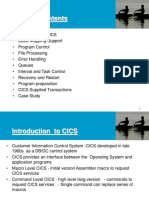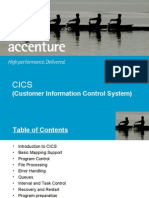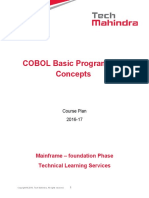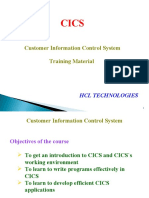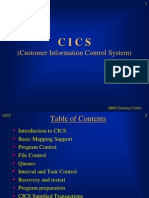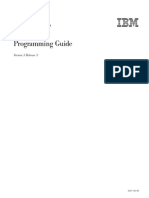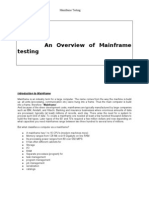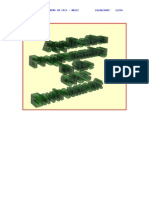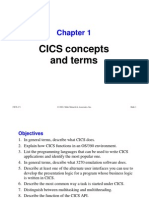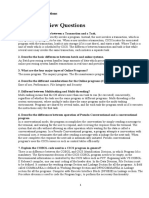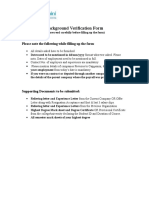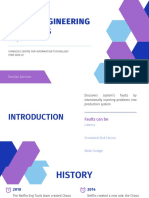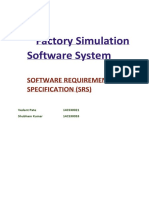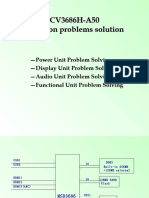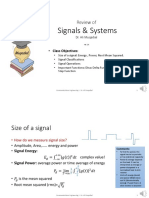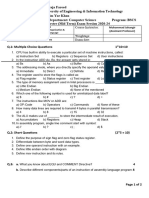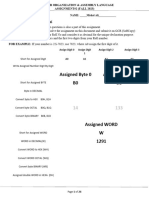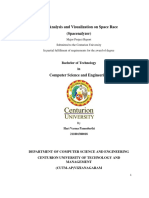30-Jun
31-Jul
31-Aug
30-Sep
31-Oct
30-Nov
COBOL
Revision
JCL
Revision
VSAM
Revision
DB2
Revision
CICS
Revision
SORT
Revision
IDCAMS
Revision
SAS
Revision
REXX
Revision
EZYTRIVE
Revision
31-Dec
�CICS
20/06/16
21/06/16
22/06/16
23/06/16
24/06/16
25/06/16
26/06/16
27/06/16
28/06/16
29/06/16
30/06/16
01/07/16
02/07/16
03/07/16
04/07/16
05/07/16
06/07/16
07/07/16
08/07/16
09/07/16
10/07/16
11/07/16
12/07/16
13/07/16
14/07/16
15/07/16
16/07/16
17/07/16
18/07/16
19/07/16
20/07/16
21/07/16
22/07/16
23/07/16
24/07/16
25/07/16
26/07/16
27/07/16
28/07/16
29/07/16
30/07/16
31/07/16
DB2
COBOL
�VSAM
JCL
SORT
IDCAMS
SAS
�REXX
�COBOL
���Chapter 1. Structuring your program
Chapter 2. Using data
Chapter 3. Working with numbers and arithmetic
Chapter 4. Handling tables
Chapter 5. Selecting and repeating program actions
Chapter 6. Handling strings
Chapter 7. Processing character data in an international environment
Chapter 8. Processing files
Chapter 9. Processing QSAM files
Chapter 10. Processing VSAM files
Chapter 11. Processing line-sequential files
Chapter 12. Sorting and merging files
Chapter 13. Handling errors
Chapter 14. Compiling under z/OS
Compiling with JCL
Using a cataloged procedure
Writing JCL to compile programs
Compiling under TSO
Example: ALLOCATE and CALL for compiling under TSO
Example: CLIST for compiling under TSO
Starting the compiler from an assembler program
Defining compiler input and output
Data sets used by the compiler under z/OS
Defining the source code data set (SYSIN)
Specifying source libraries (SYSLIB)
Defining the output data set (SYSPRINT)
Directing compiler messages to your terminal (SYSTERM)
Creating object code (SYSLIN or SYSPUNCH)
Creating an associated data file (SYSADATA)
Defining the output Java data set (SYSJAVA)
�Defining the debug data set (SYSDEBUG)
Specifying compiler options under z/OS
Specifying compiler options with the PROCESS (CBL) statement
Example: specifying compiler options using JCL
Example: specifying compiler options under TSO
Compiler options and compiler output under z/OS
Compiling multiple programs (batch compilation)
Example: batch compilation
Specifying compiler options in a batch compilation
Example: precedence of options in a batch compilation
Example: LANGUAGE option in a batch compilation
Correcting errors in your source program
Generating a list of compiler error messages
Messages and listings for compiler-detected errors
Format of compiler error messages
Severity codes for compiler error messages
Chapter 15. Compiling under UNIX
Chapter 16. Compiling, linking, and running OO applications
Chapter 17. Compiler options
Chapter 18. Compiler-directing statements
Chapter 19. Debugging
Chapter 20. Developing COBOL programs for CICS
Chapter 21. Programming for a DB2 environment
Chapter 22. Developing COBOL programs for IMS
Chapter 23. Running COBOL programs under UNIX
Chapter 24. Using subprograms
Chapter 25. Sharing data
Chapter 26. Creating a DLL or a DLL application
Chapter 27. Preparing COBOL programs for multithreading
Chapter 28. Processing XML input
Chapter 29. Producing XML output
Chapter 30. Writing object-oriented programs
�Chapter 31. Communicating with Java methods
Chapter 32. Interrupts and checkpoint/restart
Chapter 33. Processing two-digit-year dates
Chapter 34. Tuning your program .
Chapter 35. Simplifying coding
�CICS
Section I: Introduction to CICS
Section II: How to design, code, and test a CICS program
�Section III: Other CICS programming essentials
�Section IV: A complete CICS application
Section V: CICS for file and database processing
�Section VI: Advanced CICS features and skills
��Chapter 1: CICS concepts and terms
An introduction to CICS
How CICS manages multiple users
CICS services
Chapter 2: Introduction to CICS programming
How a CICS program works
The specifications and BMS mapset for an inquiry program
The design and COBOL code for the inquiry program
The CICS commands used in the program
How to develop a CICS program
Chapter 3: How to design a CICS program
The customer maintenance program
How to create an event/response chart
How to create a structure chart
Chapter 4: How to create a BMS mapset
How to design userfriendly screens
How attributes control the look and operation of a field
How to code BMS macros
The BMS mapset and symbolic map for the customer maintenance program
How to assemble a BMS mapset
�Chapter 5: How to code a CICS program
How to control the execution of the programs within a task
How to work with mapsets
How to work with files
Other coding essentials
The customer maintenance program
Chapter 6: How to test a CICS program
Introduction to CICS program testing
How to test a program from the top down
How to use the CICS service transactions for testing
Chapter 7: How to use temporary storage control
Temporary storage queue concepts
How to work with temporary storage queues
A maintenance program that uses a temporary storage queue
Chapter 8: Additional CICS commands and programming techniques
Terminal handling techniques
How to handle unrecoverable errors
How to access data using the Linkage Section
How to format the date and time
Chapter 9: How to debug a CICS abend
CICS abend codes
How to use the Execution Diagnostics Facility
�Chapter 10: A systems overview
The system design for the sample application
Program control for the sample application
Resources for the sample application
Files for the sample application
Chapter 11: The menu program
The specifications for the menu program
The design for the menu program
The BMS mapset and symbolic map for the menu program
The COBOL code for the menu program
Chapter 12: The maintenance program
The specifications for the maintenance program
An event/response chart for the maintenance program
The structure chart for the maintenance program
The BMS mapset and symbolic map for the maintenance program
Chapter 13: The order entry program
The specifications for the order entry program
An event/response chart for the order entry program
The structure chart for the order entry program
The BMS mapset for the order entry program
The programmergenerated symbolic map for the order entry progr
The COBOL code for the order entry program
The COBOL code for the GETINV subprogram
�Chapter 14: How to process files sequentially
How to use the browse commands
Two sample applications that do sequential processing
Chapter 15: How to use VSAM alternate indexes
Alternate indexing concepts
An enhanced customer inquiry program
Chapter 16: How to use other file processing features
How to use generic keys
How to use the MASSINSERT option of the WRITE command
How to use the TOKEN option of the file control commands
How to use shared data tables
Chapter 17: How to work with DB2 databases
Overview
CICS/DB2 concepts
The DB2 version of the customer inquiry program
CICS/DB2 programming considerations
Chapter 18: How to use other CICS control features
How to use interval control
How to use task control
How to use storage control
How to use recovery processing
Chapter 19: How to use CICS intercommunication features
�Intercommunication concepts
How transaction routing works
How function shipping works
How to use Distributed Program Link
Other intercommunication features
Chapter 20: How to design, code, and test a modular CICS program
Program design considerations
How to design a modular CICS program
How to code and test a modular CICS program
The customer maintenance program
Chapter 21: Introduction to CICS Web programming
CICS and the Internet
How to access CICS programs from a Web browser
Chapter 22: What else a maintenance programmer needs to know
How to use the HANDLE AID command
How to use the HANDLE CONDITION command
How to access Linkage Section data using BLL cells
How to use the LENGTH option
��������������������������93
��296
����192
�267
��448
�30
�110
186
�254
�381
383
�493
�38
59
78
�165
�264
289
�329
390
429
�485
497
500
��159
177
178
179
212
228
�245
246
262
266
287
290
292
299
314
316
�356
374
407
408
�461
484
493
�11
23
48
60
60
62
75
75
107
�110
140
155
155
178
210
225
�244
248
252
253
257
262
�317
317
360
387
403
�437
440
451
466
502
23
53
67
82
�120
192
217
�245
249
252
287
�356
374
384
408
420
423
�429
433
434
448
�124
134
225
��387
418
�484
�14
������242
��387

